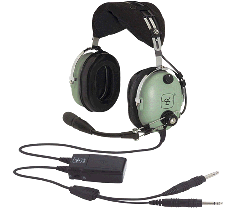 A good pair of headphones is one of the most important pieces of equipment a pilot can own. What constitutes a "good" headset?
A good pair of headphones is one of the most important pieces of equipment a pilot can own. What constitutes a "good" headset?
- Sound quality
- Noise reduction
- Comfort
- Durability
When I was shopping for headphones a couple years ago, I read a lot of recommendations. David Clark was always at or near the top of most lists, but they offer a variety of models. So I headed to an aviation store to try them out in person.
There I was able to try on about a dozen different models. I was surprised to learn how much they vary in comfort, cost, and noise cancellation. As you might expect, the more expensive headsets tend to be more comfortable and provide better noise reduction.
I was interested in a well padded set (so I could wear them for several hours) with excellent noise reduction, both active and passive. I ended up buying the H10-13X model, which has hardwired electronic noise cancellation. But even with the electronic noise reduction turned off, they gel filled ear pads block an incredible amount of sound.
To put this in context, when flying a Citabria with poor noise insulation (there's not much fabric between you and the engine), I find that 90% of the noise is blocked by the nicely sealed ear pads. The 9 volt battery powered active noise reduction is really icing on the cake.
If you happen to be in the market for a good pair of headphones for use in a noisy cockpit, I highly recommend checking out the David Clark line.
Posted by jzawodn at October 24, 2005 09:41 PM | edit
I got a set back in 1994, I'm not sure what model they are but yea, they're wonderful things. The gell earpads really cut down the noise.
Sean
I also have a set. DCs are built like tanks, and even though they say their warranty doesn't cover normal wear and tear, I've heard numerous cases where someone sends in a pair for repair, and it's either fixed under warranty, or at least upgraded to modernize it (for example add the gel seals for older headsets, etc.).
Really a great company that builds a good product. The only thing I don't like is the vise feeling after a long (3hr) cross country flight, but they're better than my passenger set...
I have a couple DC's, but recently started using a Lightspeed QFR/XC (ANR) and QFR Solo (best passive out there, I believe) instead. They're both great (and great price).
I've heard some mixed reviews of the Lightspeed models. But I suspect they just need more exposure and mindshare.
Actually, this shit is now in the flying category of my blog. Having two blogs turned out to be a dumb idea. I have redirects on the old flyin entries (but not yet the old home page).
I own a pair of H10-13XL, they are indeed great noise-reductionwise. Only drawback, the battery which drains out fast when the ENC unit is left On. To avoid such problems, be sure to turn on the auto shut-off feature, it works great and will assure a long life to your battery.
I've been using David Clark's since about 1983 or so. Now I have the 13x model. But, frankly, while they are well built and have great customer service, the ANR noise reduction is poor compared to later models of the LightSpeed, like the 25XL. So, you pay a lot, but get subpar performatnce.
www.avshop.com has lots of headset reviews by customers, by the way.
I have a DC H10-40 headset, purchased when I was learning to fly helicopters in the early 1980s. I've customized it a bit. Since I also fly fixed wing, I didn't want to have to buy another headset, so I ordered a spare airplane-style "Y" cord from David Clark and got a few sets of inline 5-pin DIN connectors. I spliced the DIN connectors into the cords, so I can easily swap between helicopter and airplane styles. Also retrofitted with gel earpads and cloth covers. Comfortable and works well. (Some time afterward, the David Clark company came out with models that have a jack in the left earcup, so one can swap cord styles.)
